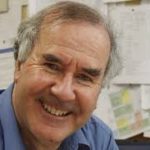|
«The IAU Strategic Plan 2020-2030, a blueprint for forging a new social revolution in astronomy and for using astronomy as a tool John Hearnshaw (Canterbury University, New Zealand) I was born in Wellington in 1946, with an English father and Aussie mother, but I grew up in the NW of England from 1948 after my father got a job there after the war. My education was in the UK where I lived for 19 years, but after graduating from Cambridge with a science degree in 1967, I did a PhD in astronomy at the Australian National University in Canberra from January 1968. I married Vickie, a Kiwi girl, in the middle of my doctoral work in December 1969 (we met in Panama when I sailed on a P&O liner from the UK in 1967). After finishing a doctoral thesis I had two short research fellowships, the first at the Paris Observatory (1972-74) and the second one at Harvard and the Smithsonian Institution in Cambridge, Mass (1974-76). In 1976 I returned to New Zealand to a lecturing position at the University of Canterbury. I was promoted to a professorship at Canterbury in 1995 and eventually retired in 2014 after 38 years. For 25 of those years I served as director of Mt John Observatory at Lake Tekapo, in three different periods. I spent a lot of time developing new instruments to use at Mt John and training graduate students in astronomy (PhD and MSc). During my time at Canterbury I wrote six books on astronomy, most of them on the history of stellar astrophysics in the last 200 years. I have also been active working for the International Astronomical Union (and still am); the IAU is the society for professional astronomers with about 12000 members world-wide. From 2003 to 2012 I chaired the IAU Program Group for the World-wide Development of Astronomy, a job that entailed travelling to developing countries to give lectures, to advise on teaching astronomy and to promote research collaborations. My travels took me to Mongolia, Cuba (twice), Venezuela (twice), Uzbekistan, Tajikistan, Mauritius, Fiji, North Korea, Uruguay, Paraguay, Trinidad and Tobago and Thailand (many times). I am currently IAU Vice-President andI am chair of the Aoraki Mackenzie International Dark Sky Reserve board, a charity that helps maintain dark skies in the Mackenzie District. TUESDAY – December 8
I will discuss the second IAU Strategic Plan for the decade 2020-30 in the context of the overall evolution of the IAU in recent past decades. This article will show how the IAU has evolved dramatically since WW2. It is hardly recognizable in terms of its original organization and goals of a century ago. What was once an inward-looking body engaged purely with the procedures of astronomical research is now a dynamic and outward-looking organization, interacting with people, especially students and the public. A large part of this success must be attributed to the IAU’s unique body of individual members, whose number has grown strongly in recent decades. It is the individual members, especially through the Commissions and Working Groups, who have promoted these enormous changes in the outlook of the Union. This is a model for other scientific unions to follow, and especially for the work to promote the careers of women in science, for promoting the careers of young astronomers, for bringing students into astronomy or into science in general, for helping people with disabilities to have careers in astronomy, for engaging with the public, and for helping to develop astronomy and science in developing countries. Looking to the future, the IAU’s new Strategic Plan for the years 2020 to 2030 (van Dishoeck & Elmegreen, 2018) has five major goals for the coming decade: |

 Invited Talk 1
Invited Talk 1